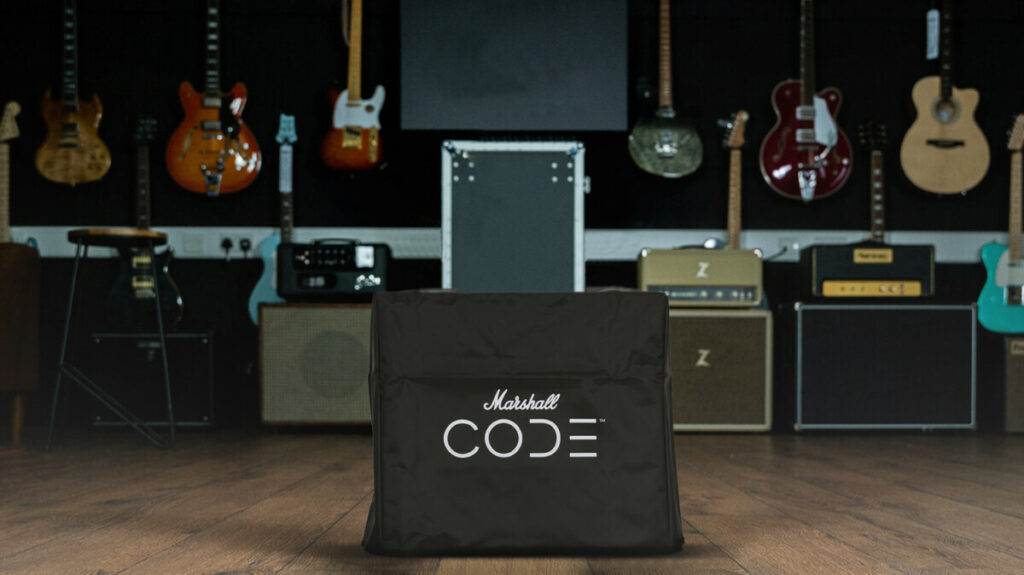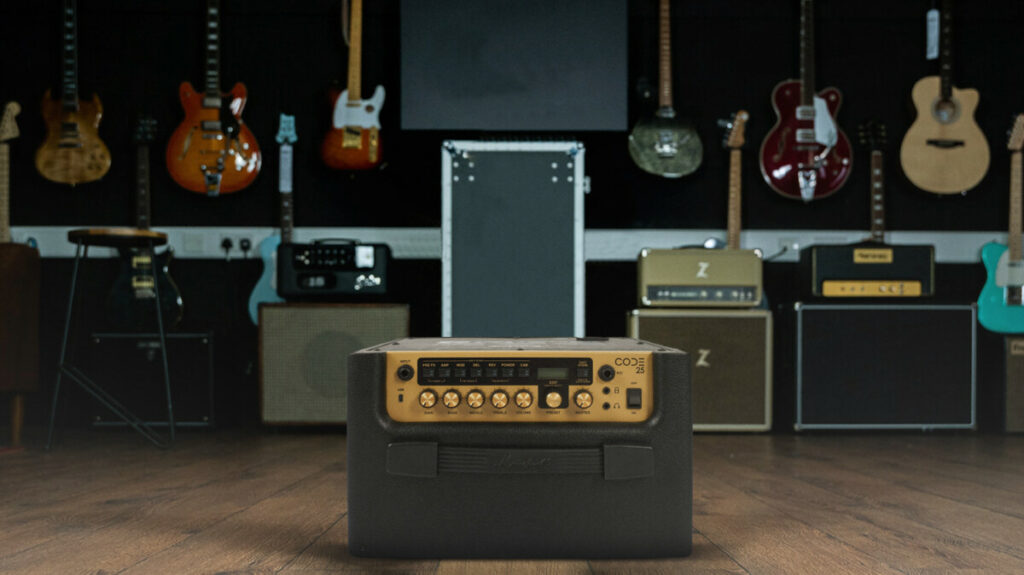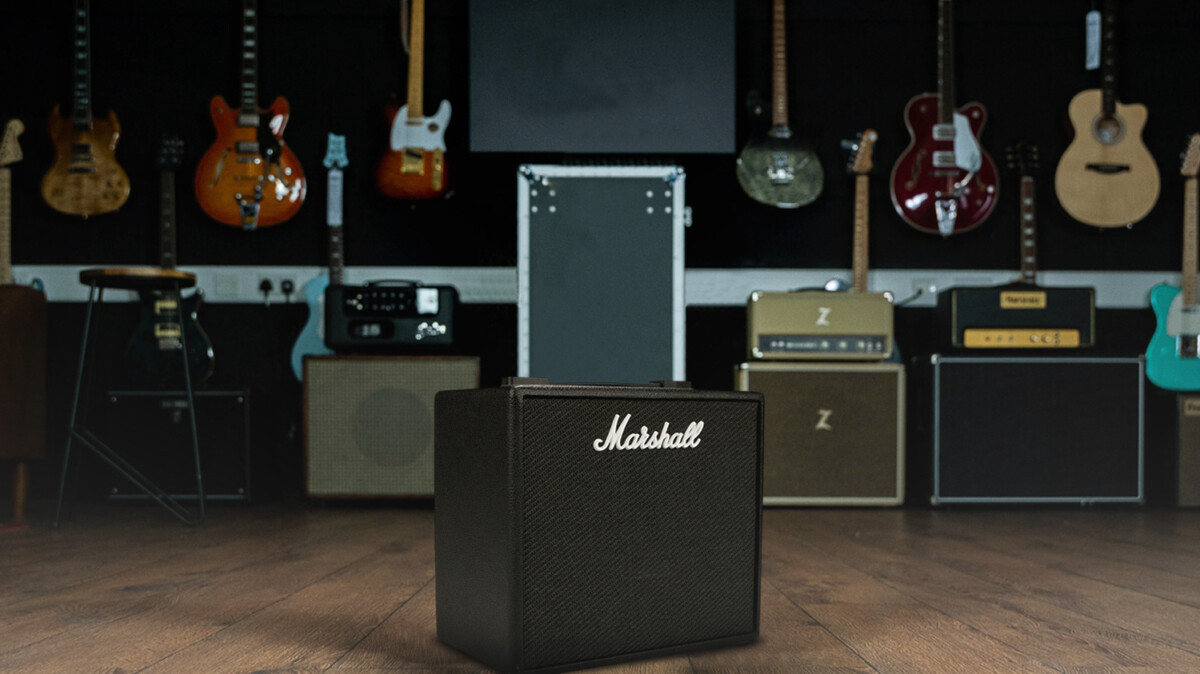For all my fellow musicians out there constantly on the prowl for training amps that don’t smash the piggy bank, I recently scored a Marshall Code 25.
So the question begging to be asked is, can this digital modeling amp hold its own within the realm of the iconic Marshall brand? With its incredible array of emulators, presets, and effects, it undoubtedly sets the bar pretty high. But can it follow through with the goods?
In this review, I’m gonna break down everything from its performance to its reliability, flirt a little with the pros, dish the dirt on the cons, and throw in a couple of alternatives as well. By doing so, I aim to give you a no-frills, straight-up, honest evaluation of what the Marshall Code 25 truly brings to the table.
Table of Contents
Design and Build Quality

The Marshall Code 25 comes in a neat little package that’s pretty easy to cart around. It’s a cool mix of black plastic coupled with a shining metallic control panel. The sleek, modern vibe works wonderfully well, especially with that classic Marshall emblem adorning the front.
Same as with the Marshall Code 50, there’s no compromising on the quality of materials here, ensuring that this amp is built to last. Whether you’re hauling it to your gigs, rockin’ out in your jam sessions, or need it for those hardcore practice tears into the night, its portability is a mega plus point. This baby isn’t a back-breaker. Its weight is a breeze to handle, and its slim size means it fits snug even in the tiniest corners.
So whether you’re hitting the road or setting up a home jam corner, the Marshall Code 25 checks all the convenience boxes. It’s your road-ready buddy, blending both portability and transportation ease into one music powerhouse.
Controls and User Interface

Navigating the controls on the Marshall Code 25 is a smooth ride, super user-friendly and intuitive. What’s really rad about it is how it allows you to tweak your sound just how you like it. Check it out:
- The analog knobs put the power right at your fingertips. Controls like Gain, Bass, Middle, Treble, Volume, Preset, and Master volume let you dial in your sound with pinpoint accuracy.
- Got push buttons with lovely little light indicators for Pre-FX, Modulations, and Presets which make flipping through different effects and presets an absolute breeze.
- A nifty little display that lets you jump from one preset to another in real-time. No waiting, just instant access to your go-to sounds.
But it keeps getting better. Marshall throws in the Gateway app, compatible with both iOS and Android, that takes convenience up a notch. Adjust settings, save custom presets, or even commandeer the amp from a distance. Talk about control, right?
Pair the Code 25 with the Gateway app, and you’re left with a plethora of sound customization options. Dive into a vast array of presets, amp models, preamp models, and guitar cabs to craft your perfect tone.
In sum, the command center on the Marshall Code 25, coupled with the bells and whistles on the Gateway app, make for an immersive and fun experience for any guitarist out to sculpt their signature sound.
Sound Quality and Performance

From my experience, and because I have tried both the Marshall Code 50 and Marshall Code 100, the sound coming out of the Marshall Code 25’s built-in speaker isn’t quite on par with what you get when you plug in a pair of headphones. Yeah, there’s a whole bunch of awesome tones and effects this amp brings to the party, but the speaker itself might fall a bit short when it comes to delivering that depth and clarity you’d expect.
Stick some headphones on, however, and it’s a whole different story. Suddenly, the sound becomes fuller, more detailed, and you really start to appreciate the range and capabilities of this amp.
Now, are there downsides? Sure. When you’re using the built-in speaker, you might have to deal with a bit of a pesky electric buzz or bass that sounds, well, woofy. For beginner to intermediate players looking for an amp to sweat it out on, this might be perfectly okay. But for the more discerning ears out there, the speaker’s sound quality might be a bit of a letdown.
To cut a long story short, the Marshall Code 25’s sound is much more impressive through headphones than its built-in speaker. Just saying.
Reliability and Issues
As much as I dig the Marshall Code 25 with its broad array of features and functions, it isn’t without a hiccup or two. There are a few glitches that have shown up on my radar and it’s only fair I share those with you. Here’s the lowdown on issues and customer experiences you might wanna know:
- Bluetooth headscratchers: Some folks haven’t exactly had a whale of a time trying to pair their smart devices with the amp via Bluetooth. When all you want is to get down to some remote preset tweaking, this can be a bit of a buzzkill.
- Dodgy presets: Heard of a few cases where the Code 25’s presets don’t save as they should or vanish into thin air – not ideal when it breaks your flow and demands a manual redo.
- Unplanned timeouts: Now and then, a customer has mentioned unwanted shutdowns mid-session. Like, right in the heart of the solo? Yeah, not cool.
- Firmware freakouts: On occasion, updating the amp’s firmware can cause a few headaches, all the way from poof-there-go-your-presets to changes in sound quality. So, tread lightly with these updates.
- Customer service rollercoasters: While the majority have high-fives for customer support, there have been instances where the ball got dropped and folks had a rough time sorting out their issues pronto.
Now, don’t get me wrong, these aren’t across-the-board issues. Plenty of users have had nothing but great things to say about the Marshall Code 25. But it’s essential to give you the full scoop so you can make an educated call when deciding if the amp is for you.
Frequently Asked Questions
How Does the Marshall CODE 25 Compare to Other Amps in the CODE Series?
In comparison to its siblings in the Code series, the Marshall Code 25 stands out with a sleek design and an array of preset options. Its app control feature is pretty handy too. On the flip side, it has some shortcomings – its built-in speaker’s performance leaves room for improvement, and occasional reliability issues can be annoying. But on balance, users seem to dig this amp for its versatility and bang-for-buck value.
Can the Marshall Code 25 Be Used for Gigs or Serious Recording?
When it comes to gigs or hardcore recording sessions, you might find that due to its smaller size and less powerful speaker, this little amp might not cut through as well as needed – both volume-wise and projection-wise. As far as studio-quality sound goes — let’s just say there may be better alternatives if you are chasing perfection.
What Are Some Reported Issues or Reliability Concerns With the Marshall Code 25?
The Achilles heel of this beast seems to range from minor Bluetooth connection hiccups now-and-then, to wonky presets, and even occasional device shutdowns. Yet overall reviews lean towards positive feedback which highlights the value-for-money factor along with super versatile features. Firmware updates could potentially iron out these teething troubles though!
Are There Any Alternatives to the Marshall Code 25 That Offer Similar Features?
There are indeed a few worthy contenders offering similar traits. Some worth considering include amps like Marshal code50-that boasts better speakers; or Fender Mustang LT-25-an alternative that stacks up nicely against our contender here
Is the Marshall Code 25 Suitable for Practicing Beginners and Intermediate Guitarists?
Marshall Code is undoubtedly a great pick for newbies & intermediates alike. It offers wide-ranging presets, amp models & effects that can really juice up the learning process. Aside from being pocket-friendly, its compactness makes it an ideal amp to tote around.
Conclusion
Wrapping it up, the Marshall Code 25 is a nifty piece of tech with its compact build and extensive features. It’s like your own pocket-sized jukebox that you can carry around.
Some might find the sound quality lacking and there are occasional hiccups with Bluetooth and presets, but hey, nothing in life is perfect. However, as a practice amp for those jamming sessions on the go or even at home—it’s got some serious power!
The controls? Super easy to use! The interface? Totally user-friendly! Whether you’re just starting out or shredding like Slash – this little beast won’t let you down.
In essence – it’s not just an amp; It’s your personal rocking buddy ready to bring down the house anytime.

